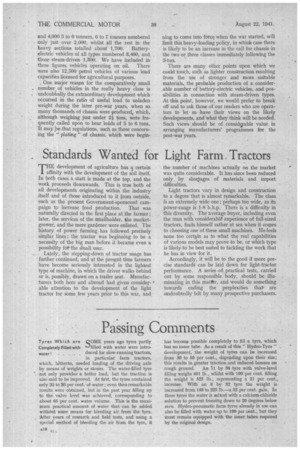Passing Comments
Page 20

Page 21

If you've noticed an error in this article please click here to report it so we can fix it.
Tyres Which are ROME years ago tyres partly Completely Filled with 1'-'filled with water were introwater pduced for slow-running tractors, in particular farm tractors, which, hitherto, needed loading of the driving axle by means of weights or stones. The water-filled tyre not only providesa better load, but the traction is also said to be improved. At first, the tyres contained only 20 to 30 per cent. of water ; even then remarkable results were obtained, but in the past year filling up to the valve level was achieved, corresponding to about 65 per cent. water volume. This is the maximum practical amount of water that can be added withdut some means for bleeding air from the tyre. After years of research and field tests, and using a special method of bleeding the air from the tyre, it has become possible completely to fill a tyre, which has no inner tube. As a result of this " Hydro-Tyre" development, the weight of tyres can be increased from 30 to 50 per cent., depending upon their size; this results in greater traction arid reduced bounce on rough ground. An 1 I by 38 tyre with-valve-level filling weighs 401 lb., whilst with 100'per cent, filling the weight is 525 lb., representing a 31 per cent.• increase. With an 8 by. 32 tyre the weight is increased from 148 to 225 lb.—a 52 per cent. gain. In these tyres the water is mixed with a calcium-chloride solution to prevent freezing down to 20 degrees below zero. Hydro.pneumatic farm tyres already in use can also be filled with water up to 100 per cent., but they must remain equipped with the inner tubes required by the original design. Much Milk Wasted -THOUSANDS of gallons of by Ban on Road I that precious food, milk,
Transport are, it is stated, being wasted daily by order. As an example of this, local dairymen in Blackpool used to obtain their milk supply largely from farms comparatively near, but the Milk Marketing Board and its system of rationalization requires the milk to be delivered to creameries many miles away and, in due course, some of it returns 143 the town in question, but not immediately, for it is not allowed to be carried by road. There may be a delay of anything from 12-24 hours, and in bot weather, particularly, it deteriorates rapidly.
AmERICA employs more men in road transport than are engaged in all other forms of transport combined, and its 4,500,000 lorries operate over 300,000 miles of main highways. Of these roads, 137,000 miles, built at an average cost of 22,000 dollars per mile,have been paid for by the taxes imposed on these vehicles during the past 10 years. Special highway taxes on the lorries alone produce sufficient to maintain every 'mile of the State highways in America, and, besides this, to build 8,800 miles of new roads. When to this amount is added the taxation imposed on private cars, the total roust be colossal.
Vast Sums Obtained from Taxing America's Motor Vehicles. . .




























































